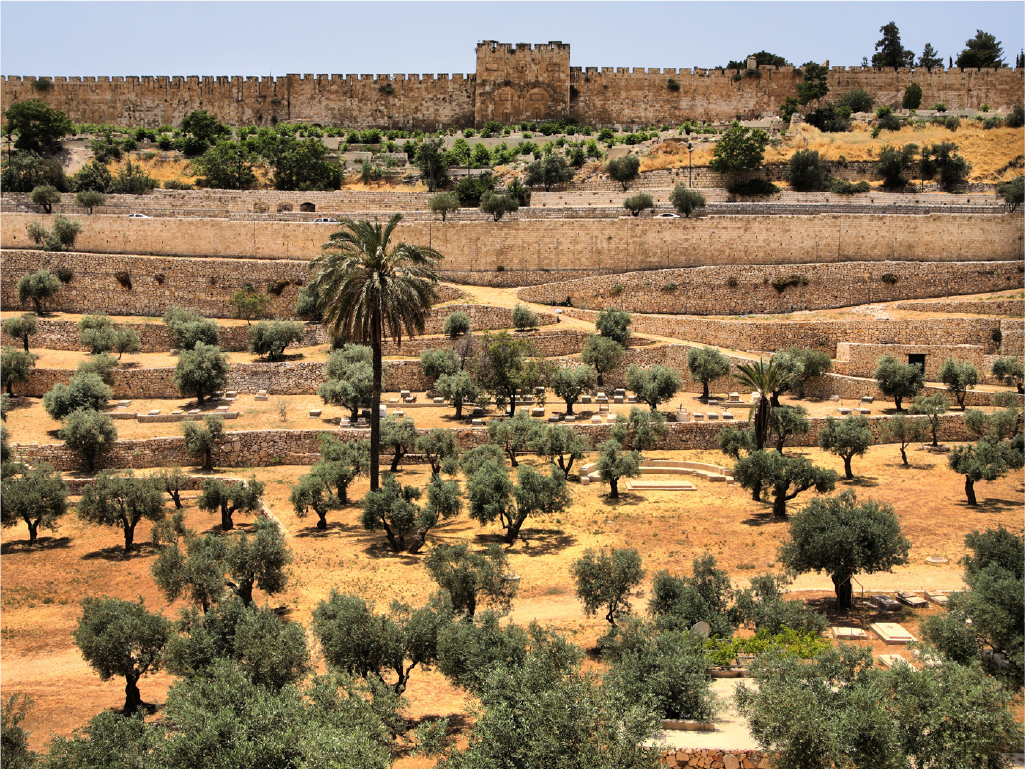
Mount of Olives
When you first arrive in Jerusalem, this two-mile long ridge is where you will most likely get your first full view of the famous City of David. Named for the olive trees that used to grow here in abundance, and where Roman legions camped during the city siege in 70 A.D., its slopes are now one of the main Jewish burial grounds for Jerusalem.
Between the Temple Mount and the Mount of Olives is the Kidron Valley, and on the hillside rising up over it are more than 150,000 Jewish graves. According to Jewish tradition, their hope is to be the first resurrected when the Messiah arrives and walks through the East Gate (Ezekiel 44:1-3). Directly in front of the East Gate are Muslim tombs that were purposely placed to block His arrival. This gate is the oldest of all the gates (dated from the time of Nehemiah). Suleiman the Magnificent sealed it in 1541 to stop Him from entering.
At almost 3,000 feet high, with a spectacular view of Jerusalem, the Mount of Olives has witnessed a lot of history: as the refuge for David when he fled from Absalom (2 Samuel 15:30), where Solomon made altars to false gods (1 Kings 11:5-7), and where King Josiah later “smashed the sacred stones and tore down the Asherah poles” to deter further abominations (2 Kings 23:14). The Prophet Zechariahalso closely identified with this area and is said to have been buried on the Mount of Olives.
In New Testament times, this was a favorite spot for Jesus, a spot where He gave His famous Olivet Discourse (Matthew 24), predicting the coming Roman destruction in 70 A.D., and where He descended into Jerusalem to the shouts of “Hosanna!” on the first Palm Sunday, thus fulfilling Zechariah 9:9.
“Rejoice greatly, Daughter of Zion! Shout, Daughter of Jerusalem! See, your king comes to you, righteous and victorious, lowly and riding on a donkey, on a colt, the foal of a donkey.”
The palms were a traditional symbol of rebellion against Roman rule by the conquered Jews, who did not understand Jesus’ peaceful mission. Palm fronds are still waved today by Jews during Sukkoth (the Feast of Tabernacles) on the Mount of Olives; one circle each day is made on the summit for the first six days to symbolize the Temple service when the priests used to circle the altar once a day.
The Garden of Gethsemane is on the lower slope. Today, the Garden is fenced off to protect the ancient Olive trees that are at least a thousand years old. Despite being where Jesus traveled to many times, the Mount is most renowned today as the spot where He ascended into Heaven (Acts 1:9-12).
There are three locations that claim this Ascension distinction. The first is the Dome of the Ascension, in a courtyard of a small mosque. Second is a church under the modern Pater Noster Church (built above Queen Helena's 4th century structure), and last is a Russian

Orthodox Church. The only thing we know from Scripture is that it was near Bethany (Matthew 26:6), which would probably rule out all three claims geographically.
Despite this, it is a majestic place to ponder all that happened when Jesus was here. It provides an excellent view of the Temple Mount. Although a peaceful area today, Zechariah 14:4 speaks of the Day of Judgment beginning on the Mount of Olives when the Messiah returns to vanquish Israel’s foes:
“On that day his feet will stand on the Mount of Olives, east of Jerusalem, and the Mount of Olives will be split in two from east to west, forming a great valley, with half of the mountain moving north and half moving south.”
If Jesus did ascend to Heaven from the Mount of Olives, then returning to this same mountain in triumph makes even more sense when you consider David’s flight as the rejected King (like the Son of David’s rejection 2,000 years ago). According to Zechariah, its remarkable recent history as a favorite spot of Jesus for fellowship, rest, and prayer, will be surpassed by a much more remarkable future event.
FROM THE SCRIPTURES
Behold, a day is coming for the LORD, when the spoil taken from you will be divided in your midst. For I will gather all the nations against Jerusalem to battle, and the city shall be taken and the houses plundered and the women raped. Half of the city shall go out into exile, but the rest of the people shall not be cut off from the city. Then the LORD will go out and fight against those nations as when he fights on a day of battle. On that day his feet shall stand on the Mount of Olives that lies before Jerusalem on the east, and the Mount of Olives shall be split in two from east to west by a very wide valley, so that one half of the Mount shall move northward, and the other half southward. And you shall flee to the valley of my mountains, for the valley of the mountains shall reach to Azal. And you shall flee as you fled from the earthquake in the days of Uzziah king of Judah. Then the LORD my God will come, and all the holy ones with him (Zechariah 14:1-5 ESV).
As he sat on the Mount of Olives, the disciples came to him privately, saying, “Tell us, when will these things be, and what will be the sign of your coming and of the end of the age?” And Jesus answered them, “See that no one leads you astray. For many will come in my name, saying, ‘I am the Christ,’ and they will lead many astray. And you will hear of wars and rumors of wars. See that you are not alarmed, for this must take place, but the end is not yet. For nation will rise against nation, and kingdom against kingdom, and there will be famines and earthquakes in various places. All these are but the beginning of the birth pains (Matthew 24:3-8 ESV).
As he was drawing near—already on the way down the Mount of Olives—the whole multitude of his disciples began to rejoice and praise God with a loud voice for all the mighty works that they had seen, saying, “Blessed is the King who comes in the name of the Lord! Peace in heaven and glory in the highest!” (Luke 19:37-38 ESV).
So when they had come together, they asked him, “Lord, will you at this time restore the kingdom to Israel?” He said to them, “It is not for you to know times or seasons that the Father has fixed by his own authority. But you will receive power when the Holy Spirit has come upon you, and you will be my witnesses in Jerusalem and in all Judea and Samaria, and to the end of the earth.” And when he had said these things, as they were looking on, he was lifted up, and a cloud took him out of their sight. And while they were gazing into heaven as he went, behold, two men stood by them in white robes, and said, “Men of Galilee, why do you stand looking into heaven? This Jesus, who was taken up from you into heaven, will come in the same way as you saw him go into heaven.” Then they returned to Jerusalem from the mount called Olivet, which is near Jerusalem, a Sabbath day’s journey away (Acts 1:6-12 ESV).




